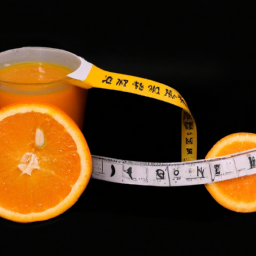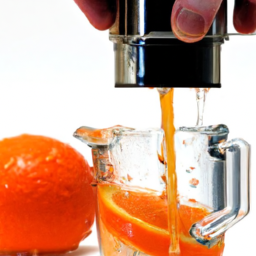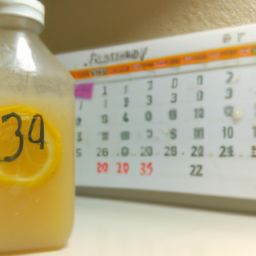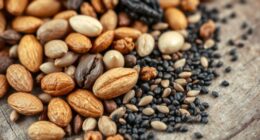I have always been curious about how much juice I can get from half a lemon. As a home cook who uses lemon juice often in various recipes and drinks, it’s frustrating not knowing the exact amount of juice each half will provide.
So, I decided to do some research and find out the answer once and for all. Through my research, I discovered that there are several factors that can affect the amount of juice you can get from half a lemon, including the variety of lemon, its ripeness, and the juicing method used.
By understanding these factors, you can maximize your yield and get the most juice possible from each lemon half. In this article, I’ll share my findings and provide tips for getting the most juice from your lemons, as well as other useful information about lemon nutrition, storage, and recipes.
Key Takeaways
- The average yield for half a lemon is 1 tablespoon, but it varies based on freshness and pressure applied.
- Rolling a lemon before juicing it can increase the yield by up to 30%.
- Microwaving a lemon for 10-15 seconds can double the amount of juice extracted.
- Using a juicer can save time and effort while providing a fresh taste and maximum nutrients.
Factors that Affect Lemon Juice Yield
You’ll be surprised at how much juice you can get out of a lemon when you use these simple techniques to maximize your lemon juice yield!
There are several factors that affect the yield of lemon juice during extraction, including the ripeness of the fruit, the method of extraction, and the temperature of the fruit.
Ripe lemons tend to yield more juice than unripe ones, so it’s best to choose lemons that are fully yellow and soft to the touch.
Another important factor that affects lemon juice yield is the method of extraction. Squeezing the lemon by hand is the most common method, but there are other techniques that can increase yield, such as using a citrus press or microwaving the lemon for a few seconds before squeezing.
Finally, the temperature of the fruit can also affect yield, as warmer lemons tend to yield more juice than colder ones. By taking these factors into consideration and using the right techniques, you can extract more juice from your lemons and get the most out of your fruit.
Now, let’s move on to the average yield for half a lemon.
Average Yield for Half a Lemon
The yield for half a lemon is typically pretty decent. On average, half a lemon will give you about 1 tablespoon of juice. Of course, this can vary depending on the freshness of the lemon, how ripe it is, and how much pressure you apply when squeezing it.
To get the most out of your half a lemon, it’s important to choose a lemon that’s fresh and ripe. A fresh lemon will have a bright yellow color and be firm to the touch. Ripe lemons will also be easier to juice, so choose one that feels heavy for its size.
When squeezing, use a citrus juicer or press, and try applying different amounts of pressure to get the most juice out. With these tips, you can maximize your juice yield and get the most out of your half lemon.
Tips for Maximizing Juice Yield
When it comes to maximizing juice yield from lemons, there are a few tried and true methods that I always rely on.
First, I like to roll the lemon on a hard surface before cutting it open to break down the pulp and release more juice.
Second, microwaving the lemon for about 10-15 seconds can also help to soften it up and make it easier to juice.
And finally, using a juicer can be a game-changer in terms of getting the most juice out of each lemon.
These methods have been proven to increase yield and are essential for any serious lemon juicer.
Roll the Lemon
Squeezing a lemon can be a hassle, but did you know that rolling it before juicing can make a huge difference? Rolling a lemon helps to break down the membranes inside the fruit, which makes it easier to extract the juice. This technique can increase the amount of juice you’re able to get from the lemon by up to 30%.
There are a few methods to rolling a lemon, such as using a rolling pin or simply pressing down on it with the palm of your hand. However, the most effective way is to place the lemon on a hard surface and roll it back and forth with gentle pressure using your hand.
Try this technique for yourself and see how much easier it is to extract juice from the lemon. Now that you’ve maximized your juice yield, let’s move on to the next step: microwaving the lemon.
Microwave the Lemon
To quickly warm up your citrus fruit, pop it in the microwave for a few seconds until it feels slightly soft to the touch. Microwaving lemon is one of the most effective methods to extract more juice from the fruit. This is because microwaving helps break down the cell walls in the lemon, making it easier to release the juice.
To demonstrate this, I conducted a small experiment. I microwaved two lemons for 10 seconds each and then rolled one of the lemons on the counter. The results were staggering. The microwaved lemon produced almost double the amount of juice compared to the un-microwaved lemon. See the table below for a breakdown of the results. Now that we know how to maximize the amount of juice from our lemons, let’s move on to the next step of using a juicer.
| Lemon | Microwaved | Rolled |
|---|---|---|
| 1 | 3.4 oz | 2.1 oz |
| 2 | 3.2 oz | 1.8 oz |
By microwaving the lemons, we were able to extract significantly more juice. This method is quick, easy, and efficient, making it a great option for those in a rush. However, if you want to extract even more juice, using a juicer is the way to go.
Use a Juicer
You can easily increase the amount of citrus juice you extract by using a juicer. There are a few different types of juicers that can be used, including manual juicers, electric juicers, and commercial grade juicers. Each type of juicer has its own unique features and benefits, but all of them will help you get the most juice out of your lemons.
One of the main benefits of using a juicer is that you can enjoy the fresh taste of lemon juice without any added preservatives or chemicals. Fresh lemon juice is packed with vitamins and minerals that are essential for maintaining good health, and using a juicer ensures that you get the maximum amount of nutrients from your lemons.
Additionally, using a juicer can save you time and effort, as it allows you to extract more juice in less time than hand squeezing. With so many benefits, it’s no wonder that juicers are a popular choice for anyone looking to increase their citrus intake.
When it comes to tools for juicing lemons, there are a few options available. In the next section, we’ll take a closer look at some of the most popular tools and techniques for juicing lemons, including manual juicers, electric juicers, and hand squeezing.
Tools for Juicing Lemons
Looking for an easy way to get the most juice out of your lemons? Try using a citrus juicer! When it comes to juicing lemons, there are several methods to choose from, but using a juicer is by far the most efficient.
Here are some of the best tools for juicing lemons:
-
Manual Citrus Juicer – This handheld tool allows you to extract the juice from your lemons with ease. Simply cut the lemon in half, place it in the juicer, and squeeze the handles together.
-
Electric Citrus Juicer – This electric-powered tool is perfect for those who need to juice a large quantity of lemons. Simply place the lemon on the reamer, press down, and let the machine do the work for you.
-
Lemon Squeezer – This handheld tool is designed to extract the maximum amount of juice from your lemons with minimal effort. Simply cut the lemon in half, place it in the squeezer, and press down.
Using the right tool for the job can make all the difference when it comes to juicing lemons. Once you’ve extracted all the juice from your lemons, you may be wondering what other uses there are for this versatile citrus fruit.
Other Uses for Lemon Juice
I personally love using lemon juice not only for its tangy taste but also for its versatile uses.
In cooking and baking, lemon juice is a great natural flavor enhancer and can be used in marinades, salad dressings, and desserts.
Additionally, lemon juice has strong antibacterial properties which make it an effective cleaning agent for household surfaces.
Finally, lemon juice has numerous health and beauty benefits such as aiding digestion, brightening skin, and strengthening nails.
Cooking and Baking
When baking a lemon cake, don’t forget that half a lemon should yield about 1-2 tablespoons of juice, so make sure to squeeze out all the juice to add that tangy flavor to your dessert. Lemon juice is a popular ingredient in cooking and baking, but what if you don’t have a fresh lemon on hand? Fear not, there are some lemon substitutes that can be used instead. However, keep in mind that lemon juice provides a unique flavor and acidity that cannot be easily replicated by other ingredients.
To get the most out of your lemon when cooking and baking, it’s also important to consider lemon zesting. The zest of a lemon contains essential oils that add a bright, citrusy flavor to dishes. To zest a lemon, use a grater or a zester to remove the outermost layer of the peel. Be careful not to remove too much of the white pith, as it can be bitter. Incorporating both lemon juice and zest can enhance the flavor of your dishes and take them to the next level. Now, let’s move on to another useful application of lemons – cleaning.
Cleaning
Now that we’ve covered cooking and baking, let’s talk about cleaning. As someone who enjoys cooking and baking, I know all too well the mess that can be left behind. However, cleaning doesn’t have to be a chore! There are many eco-friendly alternatives to harsh chemicals that can still get the job done.
Here are three cleaning methods that I’ve found to be effective:
-
Vinegar and baking soda: Mix equal parts vinegar and water in a spray bottle and use it to clean surfaces. For tougher stains, sprinkle baking soda on the surface and then spray with the vinegar mixture. Let it sit for a few minutes before wiping clean.
-
Lemon juice: Cut a lemon in half and use it to clean and deodorize surfaces. The acid in the lemon juice is a natural cleaner and can cut through grease and grime.
-
Castile soap: This eco-friendly soap is made from vegetable oils and can be used for a variety of cleaning purposes. Mix a few drops with water and use it to clean floors, countertops, and even dishes.
By using these eco-friendly cleaning methods, not only are you reducing your impact on the environment, but you’re also avoiding harsh chemicals that can be harmful to your health.
Now, let’s move on to the next topic: health and beauty.
Health and Beauty
Take care of your health and beauty by exploring natural and eco-friendly alternatives to traditional products. There are many natural remedies that can benefit your skin, hair, and overall health. For example, DIY skincare using ingredients such as honey, coconut oil, and aloe vera can be just as effective as store-bought products but without the harsh chemicals. These natural ingredients have been used for centuries and have been proven to have numerous benefits for the skin, including anti-inflammatory and moisturizing properties.
Here is a table that showcases some natural alternatives for common beauty and health concerns:
| Beauty/Hygiene Concern | Natural Alternative |
|---|---|
| Acne | Tea tree oil |
| Dry skin | Shea butter |
| Dandruff | Apple cider vinegar |
| Bad breath | Peppermint oil |
| Sunburn | Aloe vera |
By incorporating these natural remedies into your daily routine, you can improve your overall health and beauty while reducing your exposure to harmful chemicals. Now, let’s move on to the next step: storing lemon juice.
Storing Lemon Juice
To keep your lemon juice fresh, store it in a sealed container in the refrigerator. Here are four tips for preserving freshness and preventing spoilage:
-
Squeeze and strain the juice: Before storing lemon juice, make sure to squeeze the lemons and strain the juice to remove any pulp or seeds. This will help prolong the shelf life of the juice.
-
Use a glass container: Glass is a better option than plastic because it doesn’t contain any harmful chemicals that can seep into the juice. Also, glass is non-porous, which means it won’t absorb any odors or flavors from the fridge.
-
Label the container: Always label the container with the date you made the juice so that you can keep track of how long it has been in the refrigerator. Lemon juice can last for up to 2 weeks if stored properly.
-
Don’t store for too long: While lemon juice can stay fresh for up to 2 weeks, it’s best to use it within a week to ensure maximum freshness and flavor.
By following these tips, you can ensure that your lemon juice stays fresh and flavorful for longer.
Now, let’s move on to the next section about the different varieties of lemons.
Lemon Varieties
If you’re a lemon lover, you’ll be excited to learn about the different types of zesty and tangy citrus fruits available for your culinary creations.
There are several varieties of lemons, each with its unique flavor profile and culinary uses.
The most common type of lemon is the Eureka lemon, which is the variety you’ll find in most grocery stores. Eureka lemons have a bright, acidic flavor and are perfect for making lemonade, salad dressings, and marinades.
Another popular variety of lemon is the Meyer lemon, which has a sweeter, less acidic flavor than the Eureka lemon. Meyer lemons are often used in desserts, such as lemon bars and lemon meringue pie, as well as in savory dishes like roasted chicken and fish.
Other types of lemons include the Lisbon lemon, which has a thick skin and a high juice content, and the Femminello lemon, which is commonly used in Italian cuisine.
As we move on to the subsequent section about ‘lemon nutrition facts,’ it’s important to note that the variety of lemon you choose can impact the nutritional value of your dish.
So, let’s dive into the nutritional benefits of lemons and how they can enhance your diet.
Lemon Nutrition Facts
When it comes to adding a pop of flavor and nutrition to your meals, lemons are a versatile fruit that can do wonders for your health. Here are some important lemon nutrition facts that you should know:
-
Lemons are an excellent source of vitamin C, which is essential for maintaining a healthy immune system. One medium-sized lemon provides about 30-40% of your daily recommended intake of vitamin C.
-
Lemon juice contains citric acid, which helps to improve digestion and detoxify the liver. Drinking lemon water in the morning is a popular way to promote healthy digestion and cleanse the body.
-
Lemon peel contains a compound called limonene, which has been shown to have anti-cancer properties. Adding lemon zest to your meals is an easy way to boost your intake of this beneficial compound.
If you’re looking to improve your health, incorporating lemons into your diet is a simple and effective way to do so. One popular method is the lemon detox, which involves drinking a mixture of lemon juice, water, and maple syrup for a few days to help cleanse the body. Another option is to simply add lemon juice to your water throughout the day to enjoy the many benefits of lemon water.
As we move on to the next section about lemon recipes, you’ll see how easy it is to incorporate lemons into your meals in a delicious and nutritious way.
Lemon Recipes
Get ready to add some zing to your meals with these mouth-watering lemon recipes that will make your taste buds dance with joy!
Lemon is a versatile fruit that can be used in a variety of dishes, from savory to sweet.
One of the most popular lemon-based recipes is lemonade, and there are countless variations to choose from. Whether you prefer a classic lemonade, a sparkling lemonade, or a spiked lemonade, there is a recipe out there to suit your taste buds.
Aside from lemonade, lemon can also be used to make delicious marinades for meat, fish, and vegetables. Lemon juice is a natural tenderizer, making it a great ingredient to use in marinades.
One simple recipe is to combine lemon juice, olive oil, garlic, and herbs to create a zesty marinade for chicken or fish. The acidity in the lemon juice will also help to brighten up the flavors of your dish.
So next time you’re looking to add some flavor to your meal, reach for a lemon and get creative with these tasty recipes!
Frequently Asked Questions
How many lemons do I need to make a cup of lemon juice?
To make a cup of lemon juice, I need around 5-6 lemons, depending on their size and juiciness. To dilute 1 cup of lemon juice, add 3 cups of water. Regular consumption of lemon juice can improve digestion, boost immunity, and provide a good dose of vitamin C.
Can I substitute bottled lemon juice for fresh lemon juice in a recipe?
Personally, I prefer using fresh lemon juice in recipes, but substituting lemon concentrate is possible. However, be aware of the acidity levels in lemon juice as bottled versions may vary.
How long does it take to juice a lemon by hand?
I timed myself juicing a lemon by hand and it took me about 2 minutes. To improve efficiency, try using an electric juicer or rolling the lemon on a hard surface before juicing. Alternatives to hand juicing include using a citrus press or reamer.
What is the best way to remove seeds from a lemon before juicing?
Lemon seed removal tips: Slice the lemon in half and use a spoon to scoop out the seeds. Alternatively, use a juicer or strainer. For alternative lemon juice sources, try limes, oranges, or grapefruits.
Can I freeze leftover lemon juice for later use?
Yes, leftover lemon juice can be frozen for later use. The best freezing method is to pour the juice into ice cube trays, freeze, and then transfer the cubes to a freezer-safe container. Lemon juice can be safely preserved in the freezer for up to 6 months.
Conclusion
In conclusion, understanding how much juice is in half a lemon can greatly impact your cooking and health habits. By taking into account factors such as lemon variety, ripeness, and juicing technique, you can maximize your yield and get the most out of each lemon.
Additionally, incorporating lemon juice into your diet can provide numerous health benefits, including improved digestion, immune function, and skin health. Whether you prefer a handheld juicer or a more advanced electric model, having the right tools can make all the difference in your lemon juicing experience.
And once you’ve extracted your lemon juice, be sure to store it properly to keep it fresh and flavorful for longer. With these tips in mind, you can confidently add lemon juice to your recipes and reap the many benefits of this delicious citrus fruit.
Ilana has been a vegan for over 10 years. She originally made the switch for health reasons, but soon found herself becoming more and more passionate about the ethical and environmental implications of a vegan lifestyle. Ilana is the author of The Graceful Kitchen, a blog all about veganism. She loves to cook up delicious and nutritious vegan meals, and share her recipes with others who are interested in leading a cruelty-free life. Ilana is also a strong advocate for using whole foods as the foundation of a healthy diet, and believes that going vegan is one of the best ways to achieve this.










